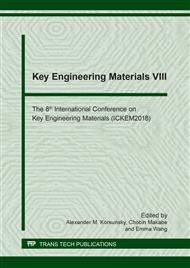[1]
M. Stoppa and A. Chiolerio, Wearable electronics and smart textiles: A critical review, Sensors, 2014, vol. 14, 11957-11992.
DOI: 10.3390/s140711957
Google Scholar
[2]
A. Mazzoldi, D. De Rossi, F. Lorussi, E.P. Scilingo and R. Paradiso, Smart Textiles for Wearable Motion Capture Systems, AUTEX Research Journal, 2002, vol. 2.
Google Scholar
[3]
P. Shyamkumar, P. Rai, S. Oh , M. Ramasamy, R.E. Harbaugh and V. Varadan, Wearable Wireless Cardiovascular Monitoring Using Textile-Based Nanosensor and Nanomaterial Systems, Electronics, 2014, vol. 3, 504-520.
DOI: 10.3390/electronics3030504
Google Scholar
[4]
K. Shaker, Y. Nawab, M.U. Javaid, M. Umair and M. Maqsood, Development Of 3D Woven Fabric Based Pressure Switch, AUTEX Research Journal, 2015, vol.15.
DOI: 10.1515/aut-2015-0015
Google Scholar
[5]
T. Seesaard, P. Lorwongtragool and T. Kerdcharoen, Development of Fabric-Based Chemical Gas Sensors for Use as Wearable Electronic Noses, Sensors (Basel), 2015, 1885-(1902).
DOI: 10.3390/s150101885
Google Scholar
[6]
J.D. Stenger-Smith, Intrinsically Electrically Conducting Polymers. Synthesis, Characterization, and Their Applications, Prog. Polym. Sci., 1998, vol. 23, 57-79.
DOI: 10.1016/s0079-6700(97)00024-5
Google Scholar
[7]
P.P. Deshpande and D. Sazou, Corrosion Protection of Metals by Intrinsically Conducting Polymers, CRC Press, (2015).
DOI: 10.1201/b19045
Google Scholar
[8]
Zh. A. Boeva and V.G. Sergeyev, Polyaniline: Synthesis, Properties, and Application, Polymer Science, 2014, vol. 56, 144-153.
Google Scholar
[9]
E.T. Kang, K.G. Neoh and K.L. Tan, Polyaniline: A Polymer With Many Interesting Intrinsic Redox States, Prog. Polym. Sci., 1998, vol. 23, 277-324.
DOI: 10.1016/s0079-6700(97)00030-0
Google Scholar
[10]
J.K. Pamatmat, A.V. Gillado, M.U. Herrera (2017).
Google Scholar
[11]
R. Neelakandan and M. Madhusoothanan, Electrical resistivity studies on polyaniline coated polyester fabrics, Journal of Engineered Fabrics & Fibers, 2010, vol. 5, 25-29.
DOI: 10.1177/155892501000500304
Google Scholar
[12]
B. Kim, V. Koncar and C. Dufour, Polyaniline‐coated PET conductive yarns: Study of electrical, mechanical, and electro‐mechanical properties, Journal of Applied Polymer Science, 2006, vol. 101, 1252-1256.
DOI: 10.1002/app.22799
Google Scholar
[13]
J. Stejskal, O. Quadrat, I. Sapurina, J. Zemek, A. Drelinkiewicz, M. Hasik, I. Křivka and J. Prokeš, Polyaniline-coated silica gel, European Polymer Journal, 2002, vol 38, 631-637.
DOI: 10.1016/s0014-3057(01)00241-5
Google Scholar
[14]
N.A. Abdul-_Manaf, O.K. Echendu, F. Fauzi, L. Bowen and I.M. Dharmadasa, Development of Polyaniline Using Electrochemical Technique For Plugging Pinholes In Cadmium Sulfide/Cadmium Telluride Solar Cells, Journal of Electronic Materials, 2014, vol. 43, 4003-4010.
DOI: 10.1007/s11664-014-3361-5
Google Scholar
[15]
N.Y. Abu-Thabit, Chemical Oxidative Polymerization of Polyaniline: A Practical Approach for Preparation of Smart Conductive Textiles, Journal of Chemical Education, 2016, 93 (9), 1606-1611.
DOI: 10.1021/acs.jchemed.6b00060
Google Scholar
[16]
I. Sapurina and J. Stejskal. The mechanism of the oxidative polymerization of aniline and the formation of supramolecular polyaniline structures, Polymer International, 2008, vol. 57, 1295-1325.
DOI: 10.1002/pi.2476
Google Scholar
[17]
B.R. Sankapal, R.S. Mane and C.D. Lokhande, Successive ionic layer adsorption and reaction (SILAR) method for the deposition of large area (~10 cm2) tin disulfide (SnS2) thin films, Materials Research Bulletin, 2000, vol. 35, 2027-(2035).
DOI: 10.1016/s0025-5408(00)00405-0
Google Scholar
[18]
U.M. Chougale, J.V. Thombare and V.J. Fulari, Synthesis of Polyaniline nanofibres by SILAR method for Supercapacitor application, IEEE, 2013, 1078-1083.
DOI: 10.1109/iceets.2013.6533537
Google Scholar


